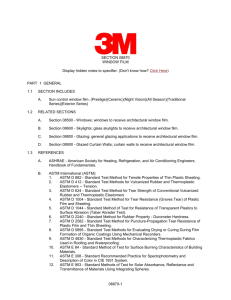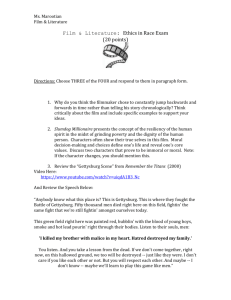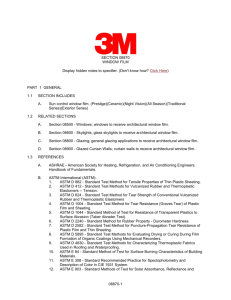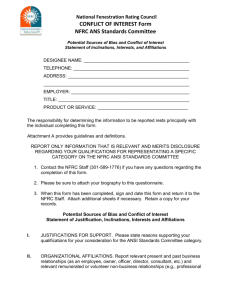SECTION 08870 WINDOW FILM Display hidden notes to specifier
advertisement
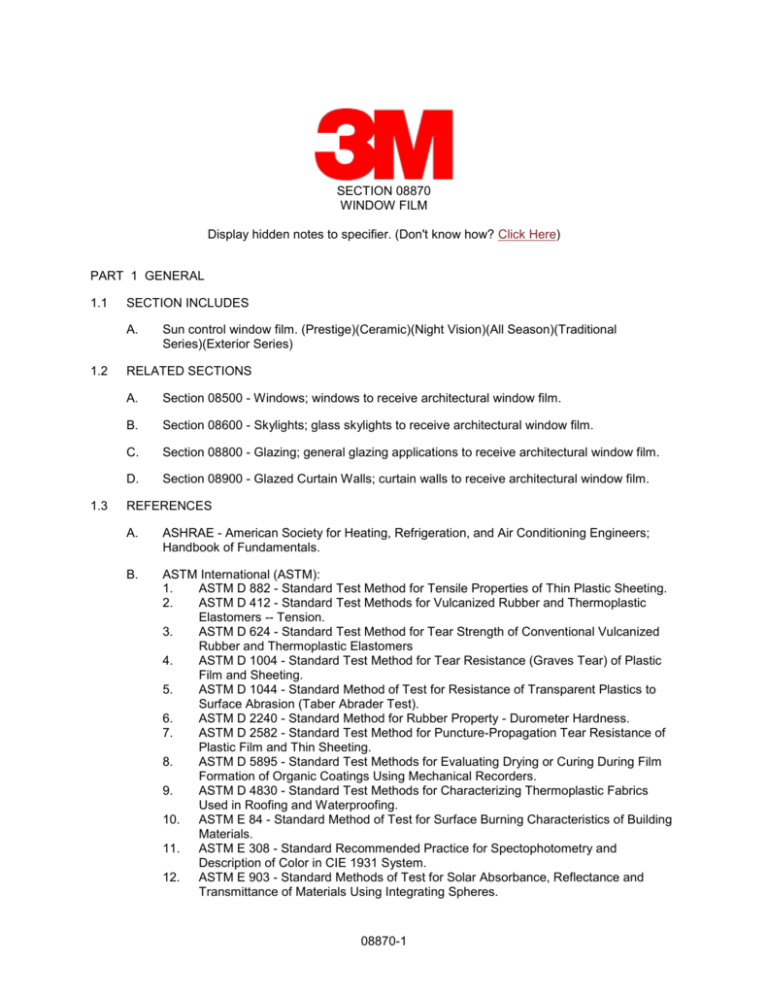
SECTION 08870 WINDOW FILM Display hidden notes to specifier. (Don't know how? Click Here) PART 1 GENERAL 1.1 SECTION INCLUDES A. 1.2 1.3 Sun control window film. (Prestige)(Ceramic)(Night Vision)(All Season)(Traditional Series)(Exterior Series) RELATED SECTIONS A. Section 08500 - Windows; windows to receive architectural window film. B. Section 08600 - Skylights; glass skylights to receive architectural window film. C. Section 08800 - Glazing; general glazing applications to receive architectural window film. D. Section 08900 - Glazed Curtain Walls; curtain walls to receive architectural window film. REFERENCES A. ASHRAE - American Society for Heating, Refrigeration, and Air Conditioning Engineers; Handbook of Fundamentals. B. ASTM International (ASTM): 1. ASTM D 882 - Standard Test Method for Tensile Properties of Thin Plastic Sheeting. 2. ASTM D 412 - Standard Test Methods for Vulcanized Rubber and Thermoplastic Elastomers -- Tension. 3. ASTM D 624 - Standard Test Method for Tear Strength of Conventional Vulcanized Rubber and Thermoplastic Elastomers 4. ASTM D 1004 - Standard Test Method for Tear Resistance (Graves Tear) of Plastic Film and Sheeting. 5. ASTM D 1044 - Standard Method of Test for Resistance of Transparent Plastics to Surface Abrasion (Taber Abrader Test). 6. ASTM D 2240 - Standard Method for Rubber Property - Durometer Hardness. 7. ASTM D 2582 - Standard Test Method for Puncture-Propagation Tear Resistance of Plastic Film and Thin Sheeting. 8. ASTM D 5895 - Standard Test Methods for Evaluating Drying or Curing During Film Formation of Organic Coatings Using Mechanical Recorders. 9. ASTM D 4830 - Standard Test Methods for Characterizing Thermoplastic Fabrics Used in Roofing and Waterproofing. 10. ASTM E 84 - Standard Method of Test for Surface Burning Characteristics of Building Materials. 11. ASTM E 308 - Standard Recommended Practice for Spectophotometry and Description of Color in CIE 1931 System. 12. ASTM E 903 - Standard Methods of Test for Solar Absorbance, Reflectance and Transmittance of Materials Using Integrating Spheres. 08870-1 13. 14. 15. 16. 17. 1.4 C. Window 6.3 - A Computer Tool for Analyzing Window Thermal Performance; Lawrence Berkeley Laboratory. D. ANSI Z97.1 - American National Standard for Safety Glazing Materials Used in Buildings Safety Performance Specifications and Methods of Test. E. IES LM-83-12: IES Spatial Daylight Autonomy (sDA) and Annual Sunlight Exposure. F. Consumer Products Safety Commission 16 CFR, Part 1201 - Safety Standard for Architectural Glazing Materials. G. GSA-TS01 - Standard Test for Glazing and Glazing Systems Subject to Airblast Loadings. H. ISO 16933, International Standard for Glass in Building: Explosion-resistant security glazing - Test and classification for arena air-blast testing. I. Underwriters Laboratories Inc. (UL): UL 972 - Burglary Resisting Glazing Material. DEFINITIONS A. 1.5 1.6 ASTM E 1886 - Standard Test Method for Performance of Exterior Windows, Curtain Walls, Doors, and Impact Protective Systems Impacted by Missile(s) and Exposed to Cyclic Pressure Differentials. ASTM E 1996 - Standard Specification for Performance of Exterior Windows, Curtain Walls, Doors and Impact Protective Systems Impacted by Windborne Debris in Hurricanes. ASTM F1642 - Standard Method of Test for Glazing and Glazing Systems Subject to Airblast Loadings ASTM F2912 - Standard Specification for Glazing and Glazing Systems Subject to Airblast Loadings. NFRC 100/200 (Formerly ASTM E903) - Standard Methods of Test for Solar Absorbance, Reflectance and Transmittance of Materials Using Integrating Spheres. Light to Solar Gain Ratio: The ratio of visible light transmission to Solar Heat Gain Coefficient. PERFORMANCE REQUIREMENTS A. Fire Performance: Surface burning characteristics when tested in accordance ASTM E 84: 1. Flame Spread: 25, maximum. 2. Smoke Developed: 450, maximum. B. Abrasion Resistance: Film must have a surface coating that is resistant to abrasion such that, less than 5 percent increase of transmitted light haze will result in accordance with ASTM D 1044 using 50 cycles, 500 grams weight, and the CS10F Calbrase Wheel. SUBMITTALS A. Submit under provisions of Section 01300. B. Product Data: Manufacturer's data sheets on each product to be used, including: 1. Preparation instructions and recommendations. 2. Storage and handling requirements and recommendations. 3. Installation methods. C. Verification Samples: For each film specified, two samples representing actual film color and pattern. 08870-2 D. 1.7 1.8 1.9 Performance Submittals: Provide laboratory data of emissivity and calculated window UFactors for various outdoor temperatures based upon established calculation procedure defined by the ASHRAE Handbook of Fundamentals, Chapter 29, or Lawrence Berkeley Laboratory Window 5.2 Computer Program. QUALITY ASSURANCE A. Manufacturer Qualifications: All primary products specified in this section will be supplied by a single manufacturer with a minimum of ten years experience. 1. Provide documentation that the adhesive used on the specified films is a Pressure Sensitive Adhesive (PSA). B. Installer Qualifications: All products listed in this section are to be installed by a single installer with a minimum of five years demonstrated experience in installing products of the same type and scope as specified. 1. Provide documentation that the installer is authorized by the Manufacturer to perform Work specified in this section. 2. Provide a commercial building reference list of 5 properties where the installer has applied window film. This list will include the following information: a. Name of building. b. The name and telephone number of a management contact. c. Type of glass. d. Type of film. e. Amount of film installed. f. Date of completion. 3. Provide a Glass Stress Analysis of the existing glass and proposed glass/film combination as recommended by the film manufacturer. 4. Provide an EFilm application analysis to determine available energy cost reduction and savings. C. Mock-Up: Provide a mock-up for evaluation of surface preparation techniques and application workmanship. 1. Finish areas designated by Architect. 2. Do not proceed with remaining work until workmanship, color, and sheen are approved by Architect. 3. Refinish mock-up area as required to produce acceptable work. DELIVERY, STORAGE, AND HANDLING A. Store products in manufacturer's unopened packaging until ready for installation. B. Store and dispose of hazardous materials, and materials contaminated by hazardous materials, in accordance with requirements of local authorities having jurisdiction. PROJECT CONDITIONS A. Maintain environmental conditions (temperature, humidity, and ventilation) within limits recommended by manufacturer for optimum results. Do not install products under environmental conditions outside manufacturer's recommended limits. PART 2 PRODUCTS 2.1 MANUFACTURERS A. Acceptable Manufacturer: 3M Window Film , which is located at: 3M Center Bldg. 0235-02S-27 ; St. Paul, MN 55144-1000; Toll Free Tel: 866-499-8857; Tel: 651-733-2222; Fax: 651737-3446; Email:3Mrenewableenergy@mmm.com; Web:www.3m.com/windowfilm 08870-3 2.2 3M PRESTIGE SUN CONTROL FILM A. Physical Properties: 1. Composition: Optically clear polyester film containing at least 220 layers and incorporating pressure sensitive adhesive on one side and an acrylic abrasion resistant coating on the other. Nanotechnology represents a breakthrough in technology due to the enhanced heat, UV and IR rejection, without the presence of any metals. The film does not contain dyes. 2. Uniformity: No noticeable pin holes, streaks, thin spots, scratches, banding or other optical defects. 3. Variation in Total Transmission across the Width: Less than 2 percent over the average at any portion along the length. 4. Thickness: Nominal 2.0 mils (0.1 mm) with no evidence of coating voids. 5. Identification: Labeled as to Manufacturer as listed in this Section. B. Performance, Prestige 70 - Clear Film, nanotechnology, no metal and at least 220 plus layers applied to 1/4 Inch (6.4 mm) Thick Clear Glass: 1. Visible Light Transmission (NFRC 100/200, ASTM E 308): 69 percent. 2. Visible Reflection - Exterior (NFRC 100/200): 9 percent. 3. Visible Reflection - Interior (NFRC 100/200): 9 percent. 4. Ultraviolet Rejected (NFRC 100/200): 99.9 percent. 5. Infrared Energy Rejected (NFRC 100/200): Up to 97 percent; as measured between 900-1000 nm. 6. Light to Solar Gain Ratio: 1.4. 7. Solar Heat Gain Coefficient (Normal Incidence) (NFRC 100/200): 0.50. 8. Total Solar Energy Rejected (TSER) at 90 Degrees (Normal Incidence) (NFRC 100/200): 50 percent. 9. Total Solar Energy Rejected (TSER) at 60 Degrees (NFRC 100/200): 59 percent. C. Performance, Prestige 60 - Clear Film, nanotechnology, no metal and at least 220 plus layers applied to 1/4 Inch (6.4 mm) Thick Clear Glass: 1. Visible Light Transmission (ASTM E 84): 60 percent. 2. Visible Reflection - Exterior (NFRC 100/200): 8 percent. 3. Visible Reflection - Interior (NFRC 100/200): 8 percent. 4. Ultraviolet Rejected (NFRC 100/200): 99.9 percent. 5. Infrared Energy Rejected (NFRC 100/200): Up to 97 percent; as measured between 900-1000 nm. 6. Light to Solar Gain Ratio: 1.3. 7. Solar Heat Gain Coefficient at 90 Degrees (Normal Incidence) (NFRC 100/200): 0.47. 8. Total Solar Energy Rejected (TSER) at 90 Degrees (Normal Incidence) (NFRC 100/200): 53 percent. 9. Total Solar Energy Rejected (TSER) at 60 Degrees (NFRC 100/200): 61 percent. D. Performance, Prestige 50 - Lightly Tinted Film, nanotechnology, no metal and at least 220 plus layers applied to 1/4 Inch (6.4 mm) Thick Clear Glass: 1. Visible Light Transmission (ASTM E 84): 50 percent. 2. Visible Reflection - Exterior (NFRC 100/200): 8 percent. 3. Visible Reflection - Interior (NFRC 100/200): 7 percent. 4. Ultraviolet Rejected (NFRC 100/200): 99.9 percent. 5. Infrared Energy Rejected (NFRC 100/200): 97 percent; as measured between 9001000 nm. 6. Light to Solar Gain Ratio: 1.1. 7. Solar Heat Gain Coefficient at 90 Degrees (Normal Incidence) (NFRC 100/200): 0.44. 8. Total Solar Energy Rejected (TSER) at 90 Degrees (Normal Incidence) (NFRC 100/200): 56 percent. 9. Total Solar Energy Rejected (TSER) at 60 Degrees (NFRC 100/200): 63 percent. 08870-4 E. Performance, Prestige 40 - Lightly Tinted Film, nanotechnology, no metal and at least 220 plus layers applied to 1/4 Inch (6.4 mm) Thick Clear Glass: 1. Visible Light Transmission (NFRC 100/200): 39 percent. 2. Visible Reflection - Exterior (NFRC 100/200): 7 percent. 3. Visible Reflection - Interior (NFRC 100/200): 7 percent. 4. Ultraviolet Rejected (NFRC 100/200): 99.9 percent. 5. Infrared Energy Rejected (NFRC 100/200): Up to 97 percent; as measured between 900-1000 nm. 6. Light to Solar Gain Ratio: 1.0. 7. Solar Heat Gain Coefficient at 90 Degrees (Normal Incidence) (NFRC 100/200): 0.40. 8. Total Solar Energy Rejected (TSER) at 90 Degrees (Normal Incidence) (NFRC 100/200): 60 percent. 9. Total Solar Energy Rejected (TSER) at 60 Degrees (NFRC 100/200): 66 percent. PART 3 EXECUTION 3.1 EXAMINATION A. 3.2 3.3 Film Examination: 1. If preparation of glass surfaces is the responsibility of another installer, notify Architect in writing of deviations from manufacturer's recommended installation tolerances and conditions. a. Glass surfaces receiving new film should first be examined to verify that they are free from defects and imperfections, which will affect the final appearance. 2. Do not proceed with installation until glass surfaces have been properly prepared and deviations from manufacturer's recommended tolerances are corrected. Prepare surfaces using the methods recommended by the manufacturer for achieving the best result under the project conditions. 3. Commencement of installation constitutes acceptance of conditions. PREPARATION A. Clean surfaces thoroughly prior to installation. B. Prepare surfaces using the methods recommended by the manufacturer for achieving the best result for the substrate under the project conditions. C. Refer to Manufacturer's installation instructions for methods of preparation for Impact Protection Adhesive or Impact Protection Profile film attachment systems. INSTALLATION A. Film Installation, General: 1. Install in accordance with manufacturer's instructions. 2. Cut film edges neatly and square at a uniform distance of 1/8 inch (3 mm) to 1/16 inch (1.5 mm) of window sealant. Use new blade tips after 3 to 4 cuts. 3. Spray the slip solution, composed of one capful of baby shampoo or dishwashing liquid to 1 gallon of water, on window glass and adhesive to facilitate proper positioning of film. 4. Apply film to glass and lightly spray film with slip solution. 5. Squeegee from top to bottom of window. Spray slip solution to film and squeegee a second time. 6. Bump film edge with lint-free towel wrapped around edge of a 5-way tool. 7. Upon completion of film application, allow 30 days for moisture from film installation to dry thoroughly, and to allow film to dry flat with no moisture dimples when viewed under normal viewing conditions. 8. If completing an exterior application, check with the manufacturer as to whether edge 08870-5 sealing is required. 3.4 CLEANING AND PROTECTION A. Remove left over material and debris from Work area. Use necessary means to protect film before, during, and after installation. B. Touch-up, repair or replace damaged products before Substantial Completion. C. After application of film, wash film using common window cleaning solutions, including ammonia solutions, 30 days after application. Do not use abrasive type cleaning agents and bristle brushes to avoid scratching film. Use synthetic sponges or soft cloths. END OF SECTION 08870-6

